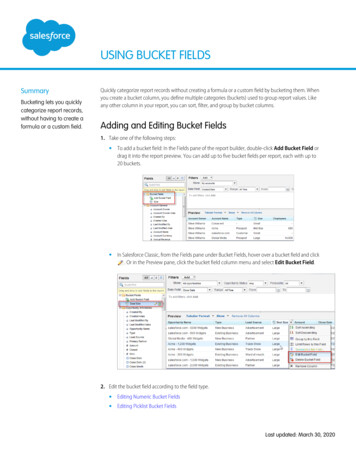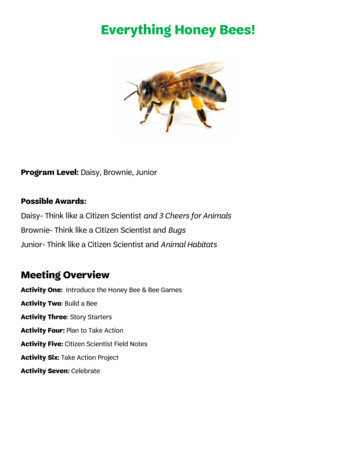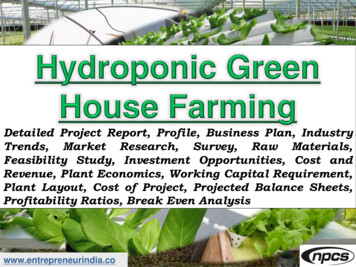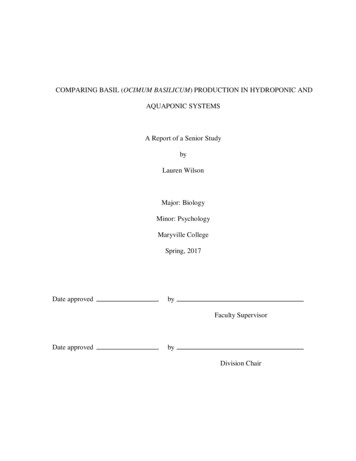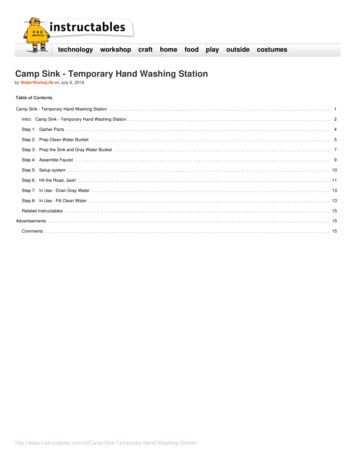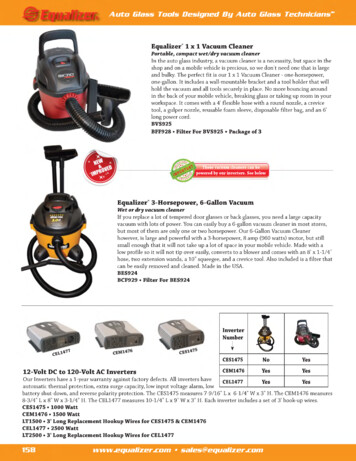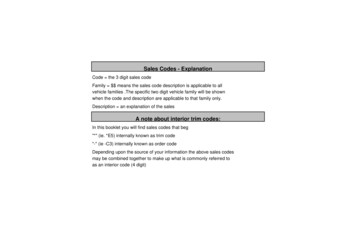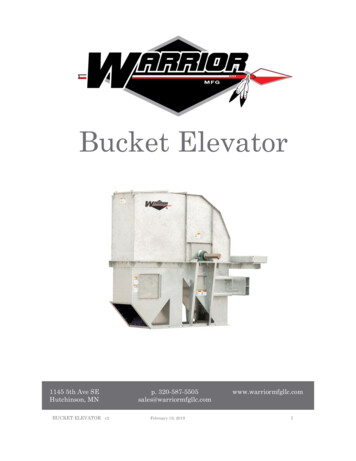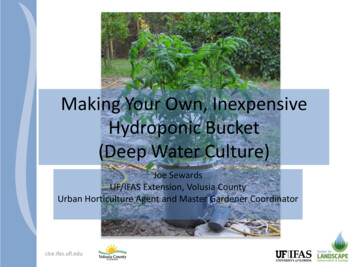
Transcription
Making Your Own, InexpensiveHydroponic Bucket(Deep Water Culture)Joe SewardsUF/IFAS Extension, Volusia CountyUrban Horticulture Agent and Master Gardener Coordinatorclce.ifas.ufl.edu
Before We Begin!! The information given today should bebeneficial to the gardening enthusiast whowishes to try hydroponics as a hobby.Commercial production of vegetables utilizinghydroponic techniques is complicated andshould be employed by only the mostcompetent grower. Commercial growers shouldrefer to Florida Cooperative Extension ServiceBulletins specifically developed for thehydroponic industry.clce.ifas.ufl.edu
What is Hydroponics? Growing plants without soil is often calledhydroponics. The name implies that the plantsare grown in water containing dissolvednutrients. However, pure water culture is onlyone of the many methods employed. All of the other methods might simply begrouped as "soilless" culture, which wouldinclude sand culture, gravel culture, and cultureutilizing other inert media substrates such asperlite, expanded clay pellets, coconut coir,pinebark and/or vermiculite.clce.ifas.ufl.edu
Deep Water Culture Deep water culture(DWC) is a hydroponicmethod of plantproduction by meansof suspending theplant roots in asolution of nutrientrich, oxygenatedwaterclce.ifas.ufl.edu
Deep Water Culture (DWC)Suspended platformclce.ifas.ufl.edu The systemconsists of acontainer with alid, a containerwith holes in thebottom, intermedia forsupport, airpump, airline,and an air stone.
DWC This type of hydroponicsystem is suitable formore “long-term” cropssuch umbersSquashBeansEtcclce.ifas.ufl.edu
DWCclce.ifas.ufl.edu Traditional methodsfavor the use of plasticbuckets with the plantcontained in a net potsuspended from thecenter of the lid and theroots suspended in thenutrient solution. An air pump poweredaquarium airstoneoxygenates the nutrientsolution. If sufficiently oxygenated,the plant roots canremain submergedindefinitely.
Plants absorb vastlymore oxygen directlyfrom the air thanfrom the oxygendissolved in water. Deep water cultureallows plant roots toabsorb largequantities of oxygenwhile also allowingthe uptake ofnutrients. This leads to rapidgrowth throughoutthe life of the plant.clce.ifas.ufl.eduDWC
Building Your Own DWC BucketSupplies list: 5 gallon bucket with lid(usually sold separately) 6 inch ( /-) pot Long-fibered sphagnummoss Either gravel, marbles,clay pellets, perlite etc. 4-leg tomato cage Small Air tubing Aquarium pumpclce.ifas.ufl.edu Air stone 20-20-20 water solublefertilizer with minorelements Epsom Salts (orMagnesium sulfate) Drill ¼” drill bit 1” hole saw Jigsaw Pliers
Bucket with lidclce.ifas.ufl.edu
Set tomato cage on lid and mark (approximately)where legs are with an indelible markerclce.ifas.ufl.edu
Using a ¼” drill bit, drill holes where legs weremarked on the lidclce.ifas.ufl.edu
Mark a hole, 6” in diameter in the lidclce.ifas.ufl.edu
Mark another, smaller hole, off to the side of thelarger hole. This will accommodate the air tube andmake it easier to add water /fertilizer solution whenneeded.clce.ifas.ufl.edu
Lid with 6” hole markedclce.ifas.ufl.edu
Drill a starter hole to cut the hole for thecontainerclce.ifas.ufl.edu
Using a jigsaw or a small keyhole saw, make the holethat will hold the containerclce.ifas.ufl.edu
clce.ifas.ufl.edu
Place container into the 6” holeclce.ifas.ufl.edu
Create the smaller hole (can be 1” or more in diameter)that will accommodate the air tube and to fill thebucket as neededclce.ifas.ufl.edu
Insert the tomato cage into the holes that werepreviously drilledclce.ifas.ufl.edu
Be sure the legs of the tomato cage touch thebottom of the bucketclce.ifas.ufl.edu
Mark the spot on the cage legs with your markerclce.ifas.ufl.edu
Remove lid and tomato cageclce.ifas.ufl.edu
Slide lid up 1” on the tomato cageclce.ifas.ufl.edu
Using pliers, bend each of the legs 90o to the sideclce.ifas.ufl.edu
Be sure this bend is 1” above the mark youcreated earlier. Then, bend it back at the originalmark so that legs point straight down again. Thiswill create a single unit.clce.ifas.ufl.edu
clce.ifas.ufl.edu
Finished bending the legsclce.ifas.ufl.edu
Replace lid and tomato cage on the bucketclce.ifas.ufl.edu
Airstones can be found at any pet supply oraquarium supply storeclce.ifas.ufl.edu
Attach one or two airstones to the air tubing. Thetubing and aquarium pump.clce.ifas.ufl.edu
Finished bucketclce.ifas.ufl.edu
Place container back into lid and put 1-2 inches oflong-fibered sphagnum moss in bottomclce.ifas.ufl.edu
Begin to fill container with inert media such as pinebark, gravel etc. about 1 inchclce.ifas.ufl.edu
Place your plant into the inert media and finishfilling the container. This simply holds the plantupright until it starts to growclce.ifas.ufl.edu
We did two buckets (hence the different color) and thisis what the tomato looked like in 3 weeks.clce.ifas.ufl.edu
Fertilizer (Nutrient) Solution 2 TEASPOONS per gallon of 20-20-20water soluble fertilizer that contains minorelements 1 TEASPOONS per gallon of Epsom Salts(Magnesium Sulfate) Brand name not important! Keep a 1 gallon jug of fertilizer solutionhandy at all times to add to bucket whenneeded.clce.ifas.ufl.edu
Home-made Macro-nutrientSolutionFormula for preparing a general purpose nutrient solution (Hoagland).Amount for 25gallons of solutionSaltGradeNutrientOz.Level tbsp.K phos.(mono-basic)TechnicalPotassium, Phosphorus½1K nit.FertilizerPotassium, Nitrogen24Ca nit.FertilizerCalcium, Nitrogen37Mg sulf.TechnicalMagnesium, Sulfur1½4clce.ifas.ufl.edu
Home-made Minor (trace) ElementSolutionFormula for solution providing trace elements.Salt (Chemical Grade)NutrientssuppliedAmount water toadd to 1 level tspsaltAmount to use for25 gal. solutionBoric acid, powderedBoron½ gal.½ pintManganese chloride (MnCl24H2O)MnCl1½ gals.½ pintZinc sulfate (ZnSO47H2O)Zinc Sulfur2½ qts.½ tsp.Copper Sulfate (CuSO45H2O)Copper Sulfur1 gal.1/5 tsp.Iron tartrate (chelated Fe330)Iron1 qt.½ cupMo trioxide (MoO3)Molybdenum1 qt.1 oz.clce.ifas.ufl.edu
A Few Hydroponic Suppliers Pentair Aquatic Eco-systems, Inc. - http://www.PentairAES.com 1-877347-4788 - net pots, hobby kits, hydroponic supplies.Hydrogardens, Inc. - http://www.hydrogarden.com 1-800-634-6362 net pots, hydroponic supplies.Verti-Gro, Inc. 1-800-955-6757 or 1-352-347-9888 – vertical and othercomplete hydroponic gardening supplies.CropKing, Inc. 1-800-321-5656 - hydroponic supplies, hobbygreenhouses.Worm's Way, Inc. 1-800-283-9676 - hydroponic supplies, hobby kits.Future Growing LLC- http://www.futuregrowing.com- hydroponicgrowing systems and supplies.Growers Supply, Division of Farm Tek http://www.growerssupply.com1-800-476-9715 hydroponic systems and greenhouse supplies.Note: This is a partial list of suppliers of hydroponic materials andsupplies. Mention of the above suppliers is not intended to be anendorsement of their product or a preference over other suppliers.clce.ifas.ufl.edu
References Stephens, J.M. May 2006. Grow Your OwnVegetables Without Soil.http://edis.ifas.ufl.edu/vh030. Hydroponic Vegetables oponic-vegetables/ Sweat, M, R. Tyson, R. Hochmuth. June2009. Building a Floating e.ifas.ufl.edu
Home-made Macro-nutrient Solution clce.ifas.ufl.edu Amount for 25 gallons of solution Salt Grade Nutrient Oz. Level tbsp. K phos.(mono-basic) Technical Potassium, Phosphorus ½ 1 K nit. Fertilizer Potassium, Nitrogen 2 4 Ca nit. Fertilizer Calcium, Nitrogen 3 7 Mg sulf. Technical Magnesium, Sulfur 1½ 4
